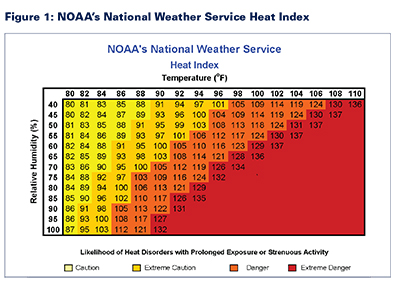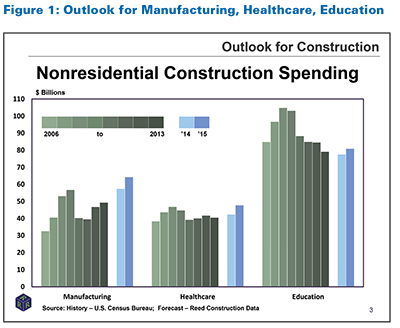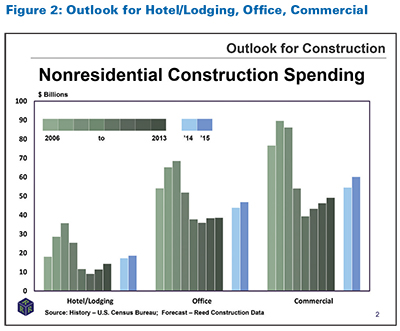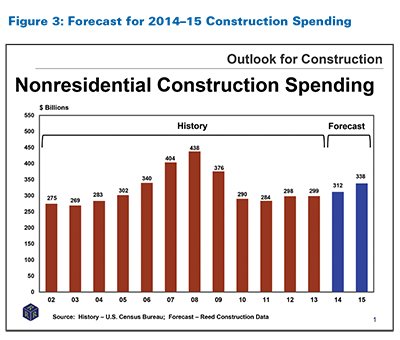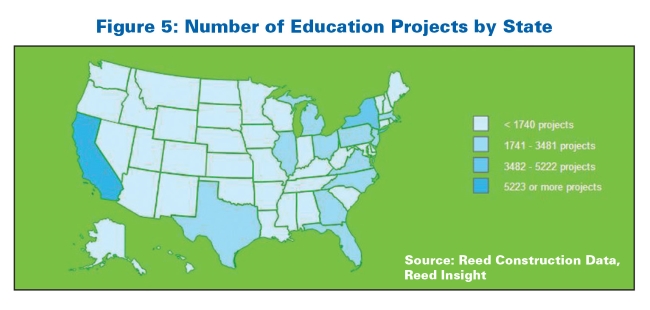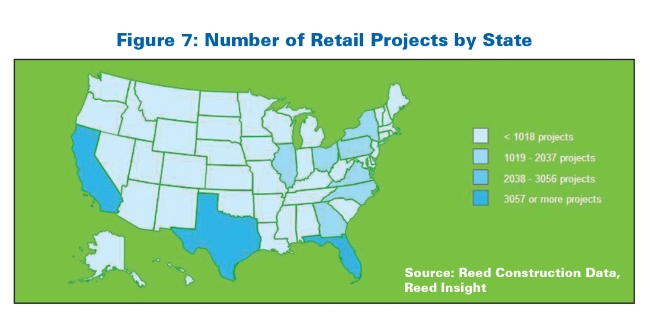Construction Market
Forecast: Slow and Steady 2014
By Tim Grogan and Tom
Ichniowski
It has been a long time coming, but
the construction recovery seems to be
almost here. The housing market has been
keeping up construction growth, which is
rebounding from record lows, but now
many of the nonresidential building
markets are starting to turn the corner,
making for many optimistic forecasts for
2014. The remaining drag on construction
growth for next year is the public
sector, which continues to be squeezed
by the battle over the federal deficit.
Some economists, however, see a
silver lining even there. “The
recession pushed millions of workers out
of the industry, and it is not going to
be easy to get them back, so a slow but
steady recovery might be the best thing
for helping to control inflation,”
says Randy Giggard, Chief Economist for
the Fails Management Institute (FMI),
Raleigh, North Carolina. “You
could make a similar argument for some
of the materials markets.”
Construction market fundamentals are
there for even stronger growth, but
markets are hobbled by political
uncertainty generated by chronic budget
battles between Democrats and
Republicans. All the forecasts collected
by the Engineering News-Record (ENR)
take into consideration this political
uncertainty, but if politics spins out
of control again, the rather optimistic
consensus among economists for 2014
could suddenly turn less sunny. For now,
all the forecasts suggest the industry
can look, as the Monty Python song says,
“on the bright side of
life.”
The McGraw Hill Construction (MHC)
forecast for 2014 is certainly on the
bright side, calling for a 9% increase
in construction starts next year. It
also predicts strong double-digit growth
in the dollar value of single-family
housing, multifamily housing, and
commercial buildings. MHC also is
forecasting that a 3-year decline in
institutional buildings will be checked
in 2014 with a modest 2% gain next year.
Manufacturing work is forecast to
increase 8% next year, following a 6%
increase this year. MHC expects public
works to fall another 5% next year,
while the power market drops 33%.
“Our outlook is positive, with
a few caveats,” says Robert Murray, MHC
Chief Economist. “This is another
step on the way to a more full-fledged
expansion,” he adds.
“Because this is a measured
expansion, there is a very good chance
this forecast will play out.”
Murray cautions the industry not to
get too excited about percent changes.
While MHC is seeing good growth in the
residential and commercial markets, and
many nonresidential building markets are
starting to turn the corner, most are
still below peak levels, Murray says.
Murray puts himself in the
“slow-and-steady is not a bad
thing” camp. “The way the
recovery is unfolding is beneficial for
2 reasons: It lessens the chance of
another boom-then-bust cycle, and it
allows for labor constraints to be less
severe,” he says.
Robert Denk of the National
Association of Home Builders (NAHB),
Washington, D.C., agrees that slower is
better-do not get too excited about
percent changes. “We are seeing
some great percent increases, but we are
still short of where we would like to
be,” he says. For Denk, a
“normal” market would be
about 1.3 million housing starts a year.
NAHB estimates that total housing starts
will increase a healthy 18%, to 924,000,
this year. NAHB predicts the market will
approach ”normal” next year,
with 1.15 million starts.
While double-digit increases in
housing are driving overall construction
growth, economists are just as excited
about some broad swings in the
nonresidential markets that they see
coming next year. Murray predicts that
Dodge starts for educational buildings
will swing from a negative 3.4% this
year to a positive 3.0% in 2014. He also
sees health care going from a minus 2.8%
this year to a plus 2.0% next year.
“The key for 2014 is institutional
buildings. Can [that market] stabilize,
or is there room for further declines?
” he asks. Murray’s forecast calls
for the institutional building market to
bounce back 2% next year, after falling
4.4% in 2013.
Similar Swings
FMI’s Randy Giggard predicts similar
swings. FMI’s forecast calls for the
office market to go from a minus 2% to a
plus 4%, for school building to go from
a 4% decline to a 4% increase, and
health-care work from down 1% to up 6%.
“Health care follows a natural
cycle, and it is just time to start
building more hospitals,” Giggard
says. “And people keep voting for
school building bonds, so that market is
looking good, too,” he adds.
The Portland Cement Association
(PCA), Skokie, Illinois, is predicting
an 8% increase in construction put-in-place next year, compared to an
estimated increase of just 1.3% this
year. The PCA forecast is a little more
bullish on public construction than
other forecasts. PCA predicts growth in
the overall public market will swing
from a negative 5.2% this year to a
positive 3.4% in 2014.
The Associated Builders and
Contractors (ABC), Washington, D.C., is
forecasting a 6% increase in
construction next year. “Our model
shows next year’s growth of 5% for
commercial construction, 7% for health
care, 8% for lodging, and 6% for
communications,” says Anirban
Basu, ABC’s chief economist.
The forecast for highway paving and
bridge work by the American Road &
Transportation Builders Association
(ARTBA), Washington, D.C., is mixed,
with tepid growth for paving work but
relatively strong growth for bridge
construction. “The 1.9% increase in
paving work we are forecasting for next
year barely even qualifies as a
rebound,” says Alison Black, ARTBA’s
chief economist. She estimates the
paving market fell 11.4% this year,
following a 3.3% decline in 2012.
“The pavement market looks pretty
sluggish over the next few years,”
she adds.
Bridge work, on the other hand, is
growing at a steady pace. ARTBA predicts
the dollar value for bridge work in 2014
will increase another 5.6%, after
increasing 7.1% this year and 5.1% in
2012.
“We have seen a big divergence
between the highway and bridge
markets,” says Black. “On
the pavement side, we have seen a
significant pullback in state and local
spending. But what is really holding
down our forecast is the questions over
the Highway Trust Fund,” she adds.
“There is very little money going
into new construction.”
Indeed, federal government funding
is a key issue for many construction
markets next year because of its
uncertainty. A congressional budget
standoff caused a 16-day shutdown of
much of the federal government in
October, further unsettling the
companies that pursue federal
construction projects.
During the shutdown, many agencies
did not award new contracts, and there
also was a temporary halt in the Corps
of Engineers’ processing of permits to
build in and around wetlands.
Finally, on October 16,
congressional leaders reached an
agreement to extend funding through
January 15 and brought federal workers
back on the job. The measure also
averted a government default by raising
the debt ceiling through February 7.
In addition, the deal called for
members of the House and Senate budget
committees to begin negotiations toward
a budget blueprint for fiscal year 2014.
If enacted, it would be the first budget
resolution to become law since 2009. The
joint House-Senate budget conference
committee held its first meeting on
October 30 and met again on November 13
but did not reach an agreement.
The conferees, led by House Budget
Committee Chairman Paul Ryan (R-WI) and
Senate Budget Panel Chairman Patty
Murray (D-WA), face a December 13
deadline to produce a deal. (Note: Since
printing, this deadline passed and was
not met. Budget negotiations are still
in progress).
Murray said the minimum goal would
be to set an overall discretionary-spending cap for 2014. While the House
approved a $966-billion limit, and the
Senate passed a $1.058-trillion cap.
If the budget conferees can agree on
a compromise “top line”
spending figure, the House and Senate
appropriations committees would set to
work to determine 2014 funding levels
for each line-item account, including
construction programs. Another open
question is whether the budget conferees
will replace the mandatory budget
sequester’s wide-ranging spending
reductions with some alternate formula
for reductions. The 2013 sequester round
cut construction spending by $4 billion,
according to ENR’s estimate.
Reprinted courtesy of
Engineering News-Record, copyright
McGraw Hill Financial, December 2/9,
2013, All rights reserved. The full
report (subscription required), is
available at
https://enr.construction.com/engineering
/subscription/LoginSubscribe.aspx?
cid=27158.
Construction Firms Expect
Growing Demand in 2014
Many firms plan to start hiring
again, and most contractors predict
demand will either grow or remain stable
in virtually every market segment this
year, according to survey results
released on January 21, 2014 by the
Associated General Contractors of
America (AGC). The survey, conducted as
part of Optimism Returns: The 2014
Construction Industry Hiring and
Business Outlook, provides a generally
upbeat outlook for the year even as
firms worry about growing worker
shortages, rising costs, and the impact
of new regulations and federal budget
cutting.
“Contractors are more
optimistic about 2014 than they have
been in a long time,” said Stephen
E. Sandherr, the AGC’s Chief Executive
Officer. “While the industry has a
long way to go before it returns to the
employment and activity levels it
experienced in the middle of the last
decade, conditions are heading in the
right direction.”
Sandherr noted that many firms plan
to begin hiring again, while relatively
few plan to start making layoffs. Forty-one percent of firms that did not change
staff levels last year report they plan
to start expanding payrolls in 2014,
while only 2% plan to start making
layoffs. However, net hiring is likely
to be relatively modest, with 86% of
firms reporting they plan to hire 25 or
fewer new employees this year.
Among the 19 states with large
enough survey sample sizes, 100% of
firms that did not change staffing
levels last year in Utah plan to start
hiring new staff this year, more than in
any other state.
Contractors have a relatively
positive outlook for virtually all 11
market segments covered in the Outlook,
in particular for private-sector
segments. For 5 of those segments, at
least 40% of respondents expect the
market to expand, and fewer than 20%
expect the market to decline in 2014.
The difference between the optimists and
pessimists-the net positive reading-is a
strong 28% for private office,
manufacturing, and the combined
retail/warehouse/lodging segments; and
25% for power and hospital/higher
education construction.
Among public-sector segments,
contractors are more optimistic about
demand for new water and sewer
construction, with a net positive of
17%. Contractors are mildly optimistic
about the market for highway
construction, with a net positive of
10%. Respondents are almost equally
divided regarding the outlook for the
other 4 segments, ranging from net
positives of 5% for public buildings, 4%
for schools, and 3% for transportation
facilities other than highways, to a
negative of 2% for marine construction.
Sandherr added that contractors’
market expectations are significantly
more optimistic than they were at this
time last year. At that time, more
contractors expected demand to shrink
for highway, other transportation,
public building, retail, warehouse and
lodging, K-12 schools, and private
offices than expected it to grow.
Many contractors also report they
plan to add new construction equipment
in 2014. Seventy-three percent of firms
plans to purchase construction
equipment, and 86% report they plan to
lease it this year. The scope of those
investments is likely to be somewhat
limited, however. Forty-four percent of
firms say they will invest $250,000 or
less in equipment purchases, and 53% say
they will invest that amount or less for
new equipment leases.
One reason firms may be more
optimistic, association officials noted,
is that credit conditions appear to have
improved. Only 9% of firms report having
a harder time getting bank loans, down
from 13% in last year’s survey. Only 32%
report customers’ projects were delayed
or canceled because of tight credit
conditions, compared with 40% a year
ago.
“While the Outlook is
significantly more optimistic than in
years past, there are still areas of
concern for most contractors,”
said Ken Simonson, AGC’s Chief
Economist. “Many firms will
struggle to find enough skilled workers,
cope with escalating materials and
health care costs, and comply with
expanding regulatory burdens.”
Ninety percent of construction firms
report they expect prices for key
construction materials to increase in
2014. Most, however, expect those
increases will be relatively modest,
with 43% reporting they expect the
increases to range between 1 and 5%.
Meanwhile, 82% of firms report they
expect the cost of providing health-care
insurance for their employees will
increase in 2014. Despite that, only 1%
of firms report they plan to reduce the
amount of health-care coverage they
provide.
Simonson noted that as firms
continue to slowly expand their
payrolls, they were likely to have a
harder time finding enough skilled
construction workers. Already, 62% of
responding firms report having a
difficult time filling key professional
and craft worker positions; two-thirds
of firms expect it will either become
harder or remain as difficult to fill
professional positions; and 74% say it
will get harder, or remain as hard, to
fill craft worker positions.
Those worker shortages are already
having an impact, the economist added.
Fifty-two percent of firms report they
are losing construction professionals to
other firms or industries, and 55%
report they are losing craft workers. As
a result, a majority of firms report
they have improved pay and benefits to
help retain qualified staff. One reason
they are likely worried is that nearly
half of the firms believe training
programs for new craft workers are poor
or below average.
Adding to their challenges, 51% of
contractors report that demand for their
services is being negatively impacted by
federal funding cuts, new federal
regulations, and/or Washington’s
inability to set an annual budget.
“It would appear that Washington
is not here to help as far as
contractors are concerned,“
Simonson noted.
Association officials added that
survey respondents would prefer that
Washington officials work on other
priorities. Seventy-seven percent of
firms reported listed having Washington
find ways to make it easier to prepare
the next generation of skilled workers
as a top priority, 63% listed repealing
all or part of the Affordable Care Act
as a top priority, and 63% listed
renewing tax deductions and bonus
depreciation for construction equipment
as a top priority.
The Outlook was based on survey
results from over 800 construction firms
from every state and the District of
Columbia. Varying numbers responded to
each question. Contractors of every size
answered over 40 questions about their
hiring, equipment purchasing, and
business plans.
The Optimism Returns: The
2014 Construction Hiring and Business
Outlook report is available in full at
www.agc.org/galleries/news/2014%20Constr
uction%20Hiring%20and%20Business%20Outlo
ok%20Report%20%282%29.pdf
Nonresidential Construction
Index (NRCI) Predicts Growth, Hiring
Concerns in 2014
Nearly all components of the FMI’s
2014 first quarter NRCI report are on
the rise. The NRCI bounced back from a
drop of 2.9 points in the fourth quarter
of 2013 to register 64.9 in the first
quarter of 2014, the highest mark yet
for the NRCI and 6.8 points better than
the first quarter in 2013. FMI’s current
report and reports from other sources
and surveys are beginning to indicate a
growing industry challenge to find and
hire more talented people.
That concern will continue,
according to 49% of FMI’s panelists who
expect growth in construction to improve
from 2.6% to 5% next year, while 36%
expect more modest growth. Few expect
slower growth, and only 3% expect more
expansive growth. The forecast for
construction growth is nearly matched
with the expectation of hiring growth.
More likely, hiring will continue to lag
growth in backlog since most panelists
do not expect to hire until they
absolutely need to and current staff is
consistently maxed out. One of FMI’s
panelists explained, “We are
focused on hiring the top talent
available before we need the help.
Waiting to hire a body because you have
more work than you can handle produces
weak results and unhappy teams.”
The question as to when to hire is
something each company will have to
answer for itself, but the report notes
that hiring talented people ranks at the
top of the challenges for 2014 given by
FMI’s panelists.
The NRCI report was prepared
by FMI. The full report is available
online at
www.fminet.com/visitor/download/fre
eDownload/id/557
After a Year of Moving
Sideways, Nonresidential Building
Activity Poised to Resume Recovery in
2014
By Kermit Baker
Nonresidential building activity had
a disappointing performance in 2013,
with spending levels largely unchanged
from those of 2012. However, 2014 looks
to be a better year, with building
activity increasing 5.8% overall,
including a double-digit gain for
commercial facilities. The recovery will
continue into 2015, with spending
increasing 8% overall and 6% for
institutional buildings.
These are some of the key findings
from the American Institute of
Architects’ (AIA’s) Consensus
Construction Forecast, conducted in
December 2013. Semiannually, the AIA
compiles results from the leading
national construction forecasters to
develop its consensus. The forecasters
lowered their outlook for 2014 from the
2013 midyear update, which had projected
7.6% growth for the coming year.
However, disruptions in the economy in
the second half of the year stalled the
construction recovery, modestly pushing
back growth rates.
Economy Moves Toward
Stronger Growth
After generating more than 5% growth
in spending in 2012-reversing a steep 4-year decline-nonresidential building
activity was poised to continue its
recovery in 2013. However, a few
roadblocks materialized: The popular
suspects included a federal budget
sequester that scaled back government
spending, a federal government shutdown,
credit restrictions for construction
projects, and rising long-term interest
rates motivated by concern that the Fed
was going to scale back its stimulus.
While all of these factors certainly
played a role in holding back more
building activity, the problem was more
encompassing. The U.S. economy appears
to have grown less than 2% last year,
well below the 2.8% pace of 2012.
Unfortunately, the United States was not
the only laggard. World economic growth
had its worst performance since the 2009
global financial meltdown, garnering
only a 2.9% growth rate, according to
estimates from the International
Monetary Fund (IMF). The economies of
virtually every major region of the
world either declined or saw slower
rates of growth last year, as compared
to 2012. Slower international growth
affected U.S. exports, which, coupled
with ongoing domestic concerns,
discouraged construction activity.
What will change in 2014? The
international economy is expected to
move back to more traditional growth
levels, with world economic growth
expected to increase almost a full
percentage point, according to the IMF.
But there are more improvements on the
horizon closer to home.
Home building is expected to see
strong gains. The slowdown in household
formations during the foreclosure crisis
is expected to reverse, and steady gains
in house prices will bolster confidence
that it is once again safe to buy a
home. The consensus is that housing
starts will increase 25% this year, but
even that pace of growth would only
produce between 1.1 and 1.2 million
starts, well below long-term trends.
Energy is a net positive for the
economic outlook. After decades in which
energy costs were a principal risk
factor to the economy, they have
transformed into a positive benefit. In
recent years, hydraulic fracturing has
dramatically increased domestic
production of both crude oil and natural
gas. As a result, household energy costs
have been trending down for the past 5
years.
The manufacturing sector is strong.
After a steep downturn in production
output during the recession, the
manufacturing sector has come roaring
back. In spite of relatively weak growth
in the overall economy, industrial
production has averaged gains of almost
4% per year over the past 4 years, the
strongest 4-year performance since the
late 1990s. Lower energy costs are a
major factor in making domestic
manufacturing more attractive,
particularly for energy-intensive
industries like steel and chemicals.
Consumer spending is increasing.
Consumer spending for large-ticket
purchases has been one of the bright
spots in the economy in recent years,
having grown 6% or more for each of the
past 4 years. With household wealth
levels now 10% above their pre-recession
high, consumer spending is likely to
continue. Encouragingly, a higher share
of the wealth gain now comes from home
equity, which is more broadly enjoyed
than other forms of wealth.
This is not to say that there will
not be economic challenges moving
forward. The unemployment rate remains
high, and 2013 ended with fewer workers
on payrolls than before the recession.
The United States has a large and
growing federal debt level, a situation
that is likely to be a contentious
political issue as the next debt ceiling
limit approaches in the next few months.
It is still too early to tell how the
economy will respond to the Fed’s
winding down of its bond-buying program.
Construction on a Solid
Footing
With the economy finally
stabilizing, there should be some
substantial improvement in the
construction outlook. Both design
activity at architecture firms and the
fundamentals of the commercial property
market point to healthy growth moving
forward.
Even with a modest dip last November
and December, the AIA’s Architecture
Billings Index (ABI) has risen in the
vast majority of the last 16 months.
With such sustained growth in design
activity, continued improvement in
construction activity will follow suit.
While the residential sector has led the
upturn in the ABI, firms specializing in
the commercial/industrial sector have
reported solid results for most of the
past year. Even firms serving the
institutional sector have generally been
reporting modest levels of growth over
the past year.
In recent months, sunbelt firms have
enjoyed the best business conditions.
These regions tended to be the most
overbuilt prior to the downturn. Now
that growth is returning, markets in
these regions are capturing a
disproportionate share of activity. For
example, a recent analysis of
construction employment growth in metro
areas conducted by AGC using U.S.
Department of Labor data reported that
metro areas in the West accounted for 5
of the top 10 areas in the country in
terms of construction jobs added over
the past year. Three of these top growth
markets were in California. Two
additional growth markets were in the
South. Still, in Boston, New York, and
Minneapolis/St. Paul, which have not
seen much population growth in recent
years, a strong economy has put these 3
in the top 10 in terms of gains in
construction employment over the past
year.
In addition to increased workloads
at architecture firms, indicators from
the construction sector point to
increased activity levels moving
forward. Commercial property values—which declined at a steeper rate
nationally than did house prices during
the recession—have recovered nicely. As
of late 2013, commercial property values
had gained back almost two-thirds of
their losses, according to data from
Moody’s/Real Capital Analytics
Commercial Property Price Index.
Other commercial market indicators
point to strength. Vacancy rates for
offices and retail facilities have been
declining recently, and occupancy rates
at hotels have been increasing. Over the
next 2 years, vacancy rates are expected
to continue to decline for offices and
retail facilities, and rents are
projected to increase, according to a
consensus forecast of industry experts
conducted last October by the Urban Land
Institute. These indicators reflect a
growing demand for commercial space.
Supply Conditions Still a
Concern
In spite of a weak overall recovery
to date, supply conditions for
nonresidential building are unusually
tight. Construction financing remains a
problem. Bank credit standards for
construction and land development loans
have eased modestly, according to the
October Federal Reserve Board Senior
Loan Officer Survey. However, the modest
easing does not offset the sharp
increase in demand for these loans that
many of the loan officers are reporting.
Contractors are having difficulty
finding workers. In spite of a high
unemployment rate among construction
workers, home builders and
nonresidential building contractors
report difficulties filling positions. A
survey by AGC in August found that
almost three-quarters of contractors
reported problems filling at least some
of their craft positions, and over half
were having trouble filling professional
positions. Only 12% of contractors that
were hiring reported no problems filling
positions.
Construction costs are also rising.
In a low-inflation environment with weak
levels of construction activity,
construction costs would be expected to
be stable at worst. However, the U.S.
Department of Labor reported that
producer prices for major nonresidential
building types have risen in the 3 to 4%
range over the past year. Overall
consumer inflation increased by only 1%
over this period, and producer prices
were up only 0.7%. Lumber, plywood, and
gypsum prices were up at a double-digit
pace over this period, with insulation
materials up almost as much.
Building Activity
Resumes
With less of a decline in government
spending, and with healthy fundamental
conditions in the nonresidential
building sector (growing property
values, declining vacancies, and
increasing rents), 2014 should produce
healthy gains in nonresidential building
activity. With spending stronger in the
private side of the economy, the
commercial/industrial building sector is
expected to be resurgent. In 2013, when
overall nonresidential building spending
saw almost no growth, spending on
commercial and industrial facilities
increased about 5%. Growth in this
sector will accelerate this year,
reaching 10%, according to the
consensus forecast panel, and will see
slightly stronger growth in 2015. The
hotel sector is expected to be the
strongest commercial sector this year,
but offices and retail space also should
see healthy gains.
Institutional building lost ground
last year, but 2014 should usher in the
long-awaited institutional building
recovery. Spending gains are expected to
reach 3.4% this year, and accelerate to
6.3% in 2015. Health care is expected to
be one of the stronger institutional
sectors this year and next, but the
education market should also see healthy
gains.
Article reprinted with
permission from AIA’s magazine,
AIArchitect, January 24, 2014 issue,
Vol. 21. This article and AIArchitect
can be accessed online at
www.aia.org/practicing/AIAB101318.

